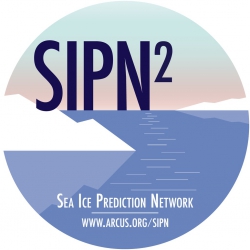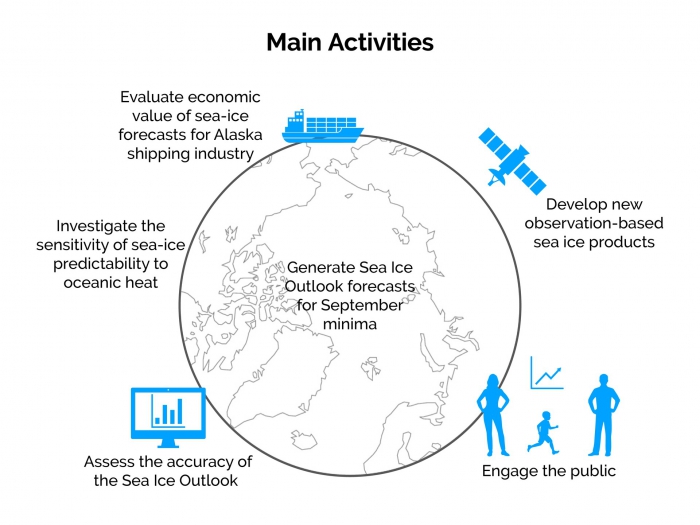By: Betsy Turner-Bogren, ARCUS Project Manager

The Sea Ice Prediction Network–Phase 2 (SIPN2) is a network of U.S. and international members working to advance research on the processes driving sea ice predictability, the production of operational products, and the communication of findings to interested stakeholders. With funding provided by NSF-Arctic Sciences Section and the U.K. Natural Environment Research Council (NERC) and additional support and in-kind contributions by several organizations, SIPN2 efforts commenced in early 2018 and will continue through 2022.
Building on the success of the Sea Ice Prediction Network (SIPN) efforts during 2014-2017, SIPN2 will improve Arctic sea ice forecasts using a multi-disciplinary approach that includes modeling, new products, data analysis, and scientific networks. Stakeholder engagement and partnerships are fostered through the open Sea Ice Outlook (SIO) process, action teams, webinars, and workshops.

SIPN2 Activities
Expanding the Sea Ice Outlook (SIO)
The annual Sea Ice Outlook (SIO) has provided an open process for those interested in Arctic sea ice to share ideas about the September minimum sea ice extent since 2008. Now part of SIPN2, the SIO produces reports in June, July, and August containing a variety of perspectives on Arctic sea ice—from observations of current conditions, to advanced numerical models, to qualitative perspectives from citizen scientists. Post-season reports provide in-depth analyses of factors driving sea ice, explore the scientific methods for predicting seasonal ice extent, and advance understanding of the impact of variables such as initial sea ice thickness, melt pond fraction, timing of melt onset and ice retreat, Bering Strait heat inflow, and weather. The goal of SIPN was to enhance scientific discussion on the physics that control summer sea ice extents. In SIPN2 there is a further analysis of quantitatively comparing model forecast output, investigating the role of oceanic heat on the limits of subseasonal-to-seasonal sea-ice predictability, and an effort to explore the economic value of two-week to seasonal scale predictions.
SIPN Data Portal
The SIPN Data Portal enables computation of sea ice probability (SIP) and the first ice-free day (IFD), along with other regional metrics from data provided by SIO contributors whose methods provide spatial information on sea ice conditions.
Outreach Activities
SIPN2 convened the Arctic Sea Ice Prediction Stakeholders Workshop in January 2018 in conjunction with the Arctic Frontiers Conference in Tromsø, Norway. This workshop brought together sea ice stakeholders and forecasters to assess the value of forecasts by the user community, determine if and how ice forecasts are currently being used in decision making and discuss which metrics are needed by various stakeholders and communicate the limits and opportunities of current forecasting systems.
The SIPN2 webinar series launched with a July webinar that provided an overview of the SIPN2 main activities and an overview of the SIPN Data Portal for sea ice prediction. A second webinar on 11 September 2018 will provide an overview of the interdisciplinary international MOSAiC program and ongoing work on the causes and consequences of an evolving and diminished Arctic sea ice cover. Webinar presentations are archived on the SIPN2 website.
Further information about SIPN2 and the Sea Ice Outlook (SIO)
For questions, contact Betsy Turner-Bogren, ARCUS (betsy [at] arcus.org)
